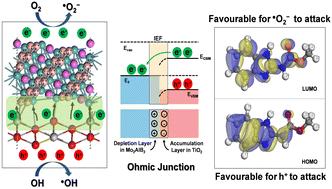当前位置:
X-MOL 学术
›
Environ. Sci.: Nano
›
论文详情
Our official English website, www.x-mol.net, welcomes your
feedback! (Note: you will need to create a separate account there.)
2D Mo2AlB2 transition-metal-aluminum-boride-phase-integrated TiO2 nanoparticles enable accelerated carbendazim photodegradation: impact of ohmic junctions and electric fields
Environmental Science: Nano ( IF 5.8 ) Pub Date : 2024-10-29 , DOI: 10.1039/d4en00727a Moorthy Gnanasekar Narendran, Aruljothy John Bosco
Environmental Science: Nano ( IF 5.8 ) Pub Date : 2024-10-29 , DOI: 10.1039/d4en00727a Moorthy Gnanasekar Narendran, Aruljothy John Bosco

|
In the quest for highly efficient nanomaterials to overcome the inherent challenges associated with fungicide elimination from water, herein, a novel ohmic junction was engineered by integrating layered 2D Mo2AlB2 with TiO2 nanoparticles using ultrasound self-assembly technique. A comprehensive array of characterization methods was employed to probe the photophysical properties of the optimized composite (TO/15-MAB). The innovative design of the ohmic junction, facilitated by its internal electric field, significantly reduced the surface charge in the TO/15-MAB composite by transferring free electrons from Mo2AlB2 to TiO2. This charge reduction enhanced the ability of the composite to attract carbendazim because of their opposing charges, promoting its swift adsorption under neutral pH conditions. Upon light irradiation, the junction accelerated the seamless transition of electrons from TiO2 to Mo2AlB2 over a curved energy band, reducing the recombination of photogenerated electrons and holes and converting them into ˙O2− and ˙OH. This culminated in the rapid degradation of 15 ppm carbendazim to ∼1 ppm with an efficiency of 93.4% and an enhanced rate of k = 0.0415 min−1, which is 4 times higher than that of bare TiO2. This assertion was supported by combined experimental and theoretical evaluation. This work showcases the excellent potential of MAB phase materials in harnessing ohmic junctions and electric fields for enhanced photocatalysis, paving the way for a highly efficient and sustainable approach to eliminating fungicides from water.
中文翻译:

2D Mo2AlB2 过渡金属硼化铝相集成 TiO2 纳米颗粒能够加速多菌灵光降解:欧姆结和电场的影响
为了寻求高效的纳米材料来克服与从水中消除杀菌剂相关的固有挑战,本文通过使用超声自组装技术将层状 2D Mo2AlB2 与 TiO2 纳米颗粒集成,设计了一种新的欧姆结。采用一系列全面的表征方法来探测优化复合材料 (TO/15-MAB) 的光物理特性。欧姆结的创新设计,在其内部电场的推动下,通过将自由电子从 Mo2AlB2 转移到 TiO2,显著降低了 TO/15-MAB 复合材料中的表面电荷。由于多菌灵的电荷相反,这种电荷减少增强了复合材料吸引多菌灵的能力,促进了其在中性 pH 条件下的快速吸附。在光照射下,结加速了电子在弯曲能带上从 TiO2 到 Mo2AlB2 的无缝转变,减少了光生电子和空穴的复合,并将其转化为 ̇O2− 和 ̇OH。这最终导致 15 ppm 多菌灵快速降解至 ∼1 ppm,效率为 93.4%,速率提高到 k = 0.0415 min-1,比裸 TiO2 高 4 倍。这一断言得到了实验和理论评估相结合的支持。 这项工作展示了 MAB 相材料在利用欧姆结和电场增强光催化方面的巨大潜力,为从水中消除杀菌剂的高效和可持续方法铺平了道路。
更新日期:2024-10-29
中文翻译:

2D Mo2AlB2 过渡金属硼化铝相集成 TiO2 纳米颗粒能够加速多菌灵光降解:欧姆结和电场的影响
为了寻求高效的纳米材料来克服与从水中消除杀菌剂相关的固有挑战,本文通过使用超声自组装技术将层状 2D Mo2AlB2 与 TiO2 纳米颗粒集成,设计了一种新的欧姆结。采用一系列全面的表征方法来探测优化复合材料 (TO/15-MAB) 的光物理特性。欧姆结的创新设计,在其内部电场的推动下,通过将自由电子从 Mo2AlB2 转移到 TiO2,显著降低了 TO/15-MAB 复合材料中的表面电荷。由于多菌灵的电荷相反,这种电荷减少增强了复合材料吸引多菌灵的能力,促进了其在中性 pH 条件下的快速吸附。在光照射下,结加速了电子在弯曲能带上从 TiO2 到 Mo2AlB2 的无缝转变,减少了光生电子和空穴的复合,并将其转化为 ̇O2− 和 ̇OH。这最终导致 15 ppm 多菌灵快速降解至 ∼1 ppm,效率为 93.4%,速率提高到 k = 0.0415 min-1,比裸 TiO2 高 4 倍。这一断言得到了实验和理论评估相结合的支持。 这项工作展示了 MAB 相材料在利用欧姆结和电场增强光催化方面的巨大潜力,为从水中消除杀菌剂的高效和可持续方法铺平了道路。






























 京公网安备 11010802027423号
京公网安备 11010802027423号